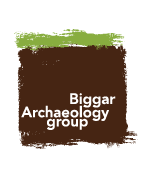
During the course of excavating on post medieval sites, especially bastle houses and 17th and 18th century settlements, a large collection of tobacco pipe bowls and stems with maker’s marks have been gathered.
Since clay pipe bowls had a short duration of use before breakage, indeed many were broken before they could be used! They offer a valuable tool in dating activity on sites. Dennis Gallagher, commissioned by BAG, has written the attached report on the assemblages of pipe bowls and stems from a series of our bastle house excavations in South Lanarkshire and also from several other projects dealing with post medieval settlement in both Lanarkshire and Peeblesshire. Images and design of the report has been completed by BAG.
The clay tobacco pipe is an artifact that became synonymous with leisure in the seventeenth century. The smoking of tobacco in pipes was introduced into Britain in the late 16th century, but it was not until the early years of the 17th century that it is recorded in Scotland (Gallagher 1987a, 3). In 1604 King James VI condemned the ‘vile custom’ in his well-known work, A Counterblaste to Tobacco, but he was not slow to realise the government’s potential monetary benefits, through taxation and the sale of monopolies. This ambivalent attitude continued; in a royal grant of 1634 of the control of licences to sell tobacco it was claimed that tobacco was first used as a medicine but was then sold everywhere, often of so poor quality that it endangered the health of the King’s subjects and depraved their morals (NAS GD103/1/131). Edinburgh was the first centre of pipe making in Scotland; William Banks appears in 1622 recorded both as a pipemaker and a retailer of tobacco (Gallagher 1987a, 3). The pipe smoking habit steadily increased and by c 1660 it had become an accepted part of everyday life. The quantity of imported tobacco, both legal and smuggled, increased from its small early beginnings to a peak in the 1680s, (Nash 1982, 355). The subsequent decrease in the price of tobacco encouraged the popularity of larger pipes.
If you would like more information on our clay pipes and our excavations, please get in touch. We’d love to know what you think of our reports and the information we provide on our website.
Report
- Tobacco pipes | Dennis Gallagher, 2011






